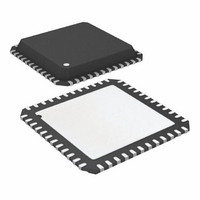AT32UC3B1256-Z1UR Atmel, AT32UC3B1256-Z1UR Datasheet - Page 240

AT32UC3B1256-Z1UR
Manufacturer Part Number
AT32UC3B1256-Z1UR
Description
MCU AVR32 256K FLASH 48-QFN
Manufacturer
Atmel
Series
AVR®32 UC3r
Datasheet
1.AT32UC3B164-AUR.pdf
(680 pages)
Specifications of AT32UC3B1256-Z1UR
Package / Case
48-QFN Exposed Pad
Voltage - Supply (vcc/vdd)
1.65 V ~ 1.95 V
Operating Temperature
-40°C ~ 85°C
Speed
60MHz
Number Of I /o
28
Core Processor
AVR
Program Memory Type
FLASH
Ram Size
32K x 8
Program Memory Size
256KB (256K x 8)
Data Converters
A/D 6x10b
Oscillator Type
Internal
Peripherals
Brown-out Detect/Reset, DMA, POR, PWM, WDT
Connectivity
I²C, IrDA, SPI, SSC, UART/USART, USB
Core Size
32-Bit
Lead Free Status / RoHS Status
Lead free / RoHS Compliant
Eeprom Size
-
- Current page: 240 of 680
- Download datasheet (10Mb)
19.13.4.2
19.13.4.3
19.13.4.4
19.13.4.5
19.13.5
19.13.5.1
32059J–12/2010
Data Transfer
Write Sequence
Clock Synchronization Sequence
General Call
Peripheral DMA Controller
Read Operation
As soon as data is written in the THR, TXRDY (Transmit Holding Register Ready) flag is reset,
and it is set when the shift register is empty and the sent data acknowledged or not. If the data is
not acknowledged, the NACK flag is set.
Note that a STOP or a repeated START always follows a NACK.
See
In the case of a Write sequence (SVREAD is low), the RXRDY (Receive Holding Register
Ready) flag is set as soon as a character has been received in the RHR (TWI Receive Holding
Register). RXRDY is reset when reading the RHR.
TWI continues receiving data until a STOP condition or a REPEATED_START + an address dif-
ferent from SADR is detected. Note that at the end of the write sequence TXCOMP flag is set
and SVACC reset.
See
In the case where THR or RHR is not written/read in time, TWI performs a clock synchronization.
Clock stretching information is given by the SCLWS (Clock Wait state) bit.
See
In the case where a GENERAL CALL is performed, GACC (General Call ACCess) flag is set.
After GACC is set, it is up to the programmer to interpret the meaning of the GENERAL CALL
and to decode the new address programming sequence.
See
As it is impossible to know the exact number of data to receive/send, the use of Peripheral DMA
Controller is NOT recommended in SLAVE mode.
The read mode is defined as a data requirement from the master.
After a START or a REPEATED START condition is detected, the decoding of the address
starts. If the slave address (SADR) is decoded, SVACC is set and SVREAD indicates the direc-
tion of the transfer.
Until a STOP or REPEATED START condition is detected, TWI continues sending data loaded
in the THR register.
If a STOP condition or a REPEATED START + an address different from SADR is detected,
SVACC is reset.
Figure 19-24 on page 241
Figure 19-24 on page
Figure 19-25 on page
Figure 19-27 on page 243
Figure 19-26 on page
describes the write operation.
241.
241.
242.
and
Figure 19-28 on page
244.
AT32UC3B
240
Related parts for AT32UC3B1256-Z1UR
Image
Part Number
Description
Manufacturer
Datasheet
Request
R

Part Number:
Description:
DEV KIT FOR AVR/AVR32
Manufacturer:
Atmel
Datasheet:

Part Number:
Description:
INTERVAL AND WIPE/WASH WIPER CONTROL IC WITH DELAY
Manufacturer:
ATMEL Corporation
Datasheet:

Part Number:
Description:
Low-Voltage Voice-Switched IC for Hands-Free Operation
Manufacturer:
ATMEL Corporation
Datasheet:

Part Number:
Description:
MONOLITHIC INTEGRATED FEATUREPHONE CIRCUIT
Manufacturer:
ATMEL Corporation
Datasheet:

Part Number:
Description:
AM-FM Receiver IC U4255BM-M
Manufacturer:
ATMEL Corporation
Datasheet:

Part Number:
Description:
Monolithic Integrated Feature Phone Circuit
Manufacturer:
ATMEL Corporation
Datasheet:

Part Number:
Description:
Multistandard Video-IF and Quasi Parallel Sound Processing
Manufacturer:
ATMEL Corporation
Datasheet:

Part Number:
Description:
High-performance EE PLD
Manufacturer:
ATMEL Corporation
Datasheet:

Part Number:
Description:
8-bit Flash Microcontroller
Manufacturer:
ATMEL Corporation
Datasheet:

Part Number:
Description:
2-Wire Serial EEPROM
Manufacturer:
ATMEL Corporation
Datasheet:










